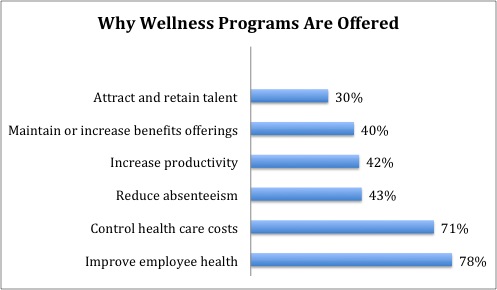Top 10 Tips for your Wellness Program

Here are top 10 tips for designing and implementing an effective Employee Wellness Program:
- Deciding who your program is for
For reasons of both cost and common sense, one of the first things to consider is exactly who, within your employee population, you are implementing the Wellness Program for. If your workforce is like the most, it includes people with a mix of health risks and profiles. One of the best ways to make your program cost-effective is to carefully assess the population to which the program is being addressed and then target interventions appropriately.
Tip 1: Understand your workforce: A simple health risk assessment followed by biometric screens and analyzing health insurance utilization pattern is a good way to assess and target appropriate interventions.
2. Deciding what scale program to aim for:
Although we all want to implement a well-balanced wellness program, rich in opportunities for employees to adopt healthy behavior and health situation, this is not something that can be rolled out in the first month. The pace at which you proceed, as well as the peak level your program might reach when it is up an running, depend on your company’s size and resources;
Tip 2: Create a plan: Develop a detailed plan that outlines short and long term objectives, budgets and expected outcomes
3. Deciding what health issues and behaviors your Program will address
Next, you will want to decide what health risks and behaviors your program will address. This can be divided into two categories:
- Program elements that promote a healthy lifestyle among all employees
- Targeted program responses to actual health risks and conditions facing current employees
Both are important, since living a fit and healthy life will improve practically every other health risk of condition – but some conditions inevitably need more treatment than simple lifestyle changes can provide
Tip 3: If you can’t do everything, at least do something. The fact that your organization lacks the time of financial resources to implement a perfect wellness plan should not stop you from doing something well
4. Set up a Wellness Committee
Set up a wellness committee with “Wellness Champions” who will help drive your wellness program. Choose leaders within the organization who are respected by their peers.
Tip 4: Make Champion status an honor and others will want to serve
5. Communication
Health education is important to every wellness program. Although there is plenty of information publicly available, you can help make sure your employees get the most accurate, up-to-date health news plus positive messages about how to make beneficial life changes.
Tip 5: People are willing to accept information about change in different ways at different times – Give your people lots of ways to encounter your health messages and plenty of opportunities to do so throughout the year.
6. Organized activities
Plan visible activities that employees can actively join, such as group-walking , back-safety classes, stress management or basic ergonomic exercises.
Tip 6: Bring action to your communication to motivate people to get out of their chairs and not only think about the messages, but to actually participate
7. Personal coaching and counseling
You may have employees who have specific, immediate health risks or needs, not all of which will be shared by the rest of your workforce. Personal coaching and counseling is effective in such cases.
Tip 7: individual coaching and follow-up is a worthwhile program option because it provides human interaction around employee’s health improvement goal
8. Include families
Although your employees spend most of their waking hours at workplace, eventually they will go home. The environment that awaits them may not be as health savvy as your workplace is becoming. If you really want some changes to happen in employees health behavior, it would be beneficial to include families. It might cost more on the front end, but you will get better results down the line
Tip 8: Expand your wellness program to include family members at least in selected activities. Yes, this will increase your expenses, but will improve your outcomes
9. Supportive Workplace Environment
It is crucial that you gear your workplace environment toward respecting and actively supporting your wellness program. IF your company says one thing in its wellness communication, but fails to follow through, or conveys a conflicting message in everyday practice, your employees will assume the wellness program is just a talk.
Tip 9: “Walking the Talk “directly from senior management are exceptionally powerful motivation tools about the importance of healthy living
10. Track Results
A quality wellness program should aim at quarterly reports as a scorecard that tallies employees’ participation in various activities and outcomes; completed satisfaction surveys; and statistics showing the reduced prevalence of risk factors and readiness to change amongst all employees. The ultimate question is did your Wellness Program add value?
Tip 10: Evaluate your wellness program regularly to measure the impact on employee engagement and medical costs. Be flexible and listen to your employees on how to improve the program.
